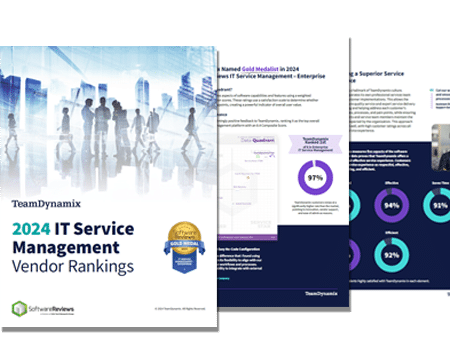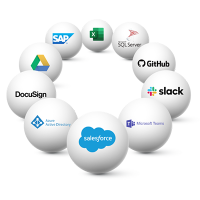
The Benefits of Project Portfolio Management for IT
As an IT leader, managing multiple projects can be overwhelming, especially when they all have different priorities and timelines. This is where Project Portfolio Management

The Info-Tech ranking report offers a unique view of the market based entirely on in-depth customer interviews. Download the Info-Tech ITSM Quadrant and Customer Viewpoint report today.

We’ll show you some of our best situations and show you exactly how to execute them to get immediate results. The best part is, iPaaS tools often feature easy-to-use click and drag functionality, meaning you don’t need a dedicated employee building integrations and workflows.

System Integrators, Value Added Resellers, Technology Providers, and Buying Consortiums can benefit from a partnership with TeamDynamix.

The Info-Tech ranking report offers a unique view of the market based entirely on in-depth customer interviews. Download the Info-Tech ITSM Quadrant and Customer Viewpoint report to gain a better understanding of key vendor strengths and emerging market requirements.
In an era where customer service is rapidly evolving, understanding the preferences of Gen Z and millennial customers and end-users is crucial. These tech-savvy generations have a clear inclination towards self-service, a trend that IT departments cannot afford to overlook. In this blog post, we’ll delve into the statistics underscoring this shift to self-service and discuss its implications for the IT Service Management (ITSM) landscape. We also offer practical strategies on how IT departments can adapt and thrive in this new IT service paradigm.
According to new research from Gartner, 38 percent of Gen Z and millennial customers say they are likely to give up on a customer service issue if they can’t resolve it in self-service. This is a shift, Gartner says, compared to the behavior of Gen X and baby boomers who are most likely to contact an agent if self-service fails.
When you put this into the context of IT and take into account that Gen Z and millennials make up much of the working population – the importance of self-service IT is clear. In order to best serve employees, customers and any other end-users, IT departments must invest time and resources into building out an effective, searchable knowledge base and easy-to-use self-service portal.
“The biggest shift we’re seeing when it comes to Gen Z and millennials is a strong preference for self-service,” Michael Rendelman, Senior Specialist, Research, in the Gartner Customer Service & Support practice, said in a recent press release Q&A on the research findings. “A Gartner survey of 6,138 customers conducted in December 2022 found that 38% of Gen Z and millennial customers say they’re likely to give up on resolving a customer service issue if it can’t be resolved in self-service. This indicates a preference for solving issues themselves, but it could also mean a reluctance to speak to a customer service rep.”
According to Rendelman, the “self-service or no-service” mindset is one that can have far-reaching implications for support organizations as well as the larger business organization. In fact, Gen Z and millennials surveyed said if their issue couldn’t be quickly resolved using self-service they:
For IT departments supporting employees and customers – a lack of self-service could me a drop in business, a drop in brand loyalty, and could spell trouble when it comes to retaining talented employees.
For many IT organizations, self-service is something they want to invest in, but it tends to take a back seat to other projects. This can be a costly mistake.
Having a well-organized self-service portal and knowledge base with the ability to search for solutions by keywords or tags goes a long way in quickly helping users get the information they need.
Self-service can deflect calls from the helpdesk to the portal and give users access to an intuitive, timely catalog of technical knowledge not only improving customer satisfaction but also dramatically reducing the per-incident cost incurred by IT.
Ideally, your ITSM software should offer an out-of-the-box self-service portal with a knowledge base (KB) that’s easily configurable and can be personalized with your organization’s branding WITHOUT any coding or scripting. In addition, the portal should be at least WCAG 2.0 AA compliant and fully accessible.
“Enabling customers to resolve their issues in self-service is ideal, but if it fails, it’s far better to help customers switch to assisted service than to let them give up entirely,” Rendelman said. “Many younger customers won’t make that switch on their own, so service leaders should look for ways to promote the switch for key issue types.”
To start, it should be easy for your end-users to submit a ticket for their issue if they can’t resolve it on their own. You can do this by using easily accessible dynamic forms on your portal that can kick off automated workflows and get routed to the proper place automatically for resolution.
Secondly, you can invest in a conversational AI chatbot for your self-service portal to provide additional assistance to your customers, employees and any other end-users. Unlike traditional chatbots that rely on pre-set responses, conversational AI chatbots utilize natural language processing and understand intent. While they do need to be trained, with conversational AI you can facilitate more complex conversations and resolve issues through actions vs. the traditional chatbot’s question/answer limited dialog path. You can also set these conversational AI chatbots up to failover to live chat when necessary.
Conversational AI especially benefits service management teams when paired with enterprise integration and automation. This combination can elevate chat from a glorified knowledge base search engine into an automated, action-centered channel to field requests.
So, what does this look like?
Let’s say you have an employee who comes to your portal because they are having issues finding information about how much PTO they have. With conversational AI chat on the portal, they can start to resolve their problem by asking the chatbot how much paid time off (PTO) they have left for the year. A traditional chatbot may not be able to answer that, instead offering a link to the employee knowledge base article about how much PTO each employee gets annually. Not only is this not helpful, but it wastes the time of the employee trying to solve their problem through self-service.
But with a conversational AI chatbot tied to a well-connected integration and automation layer, the chatbot can personalize the response leveraging Single Sign-On, and then access the employee’s data from another application to deliver an accurate, fast response.
In this case, the response may say, “Currently, you have 12 days of PTO left this year.” It might even follow up with a question like, “Do you want to know how many of these days will roll over next year?” or, “Would you like to request time off?” If the end-user response is to request time off, the solution would present a form for the request to be entered and then that data gets passed back to the PTO tracking platform and submitted.
Adapting to the changing service preferences of Gen Z and millennials is not just an option, but a necessity for IT organizations. By embracing self-service and integrating it seamlessly with assisted service through conversational AI chat, businesses can enhance both customer and employee satisfaction and loyalty. Furthermore, empowering your IT service desk employees with insights from self-service channels can drastically improve their efficiency and effectiveness.
Looking for examples of stellar self-service portals? Check these out.

As an IT leader, managing multiple projects can be overwhelming, especially when they all have different priorities and timelines. This is where Project Portfolio Management

IT Service Management (ITSM) is evolving and with it, many IT leaders are seeking ways to improve service delivery. In a recent market study, 78%

For nearly all organizations, IT Service Management (ITSM) stands as the backbone of operational efficiency, ensuring that IT services align not just with the needs
TeamDynamix’s award-winning SaaS cloud solution offers IT Service and Project Management together on one platform with enterprise integration and automation.
[email protected]
(877) 752-6196
Contact Us
